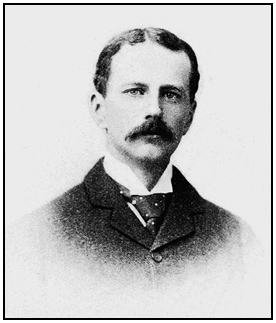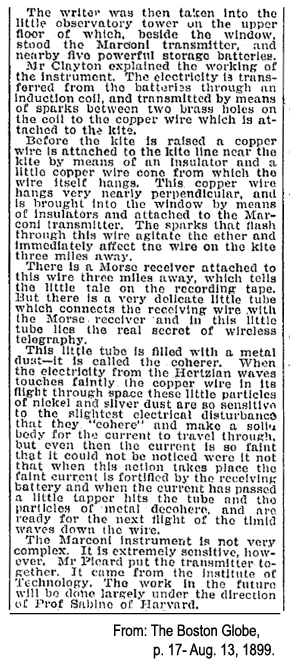 During August of 1899 Lawrence Rotch, meteorologist and founder of the Blue Hill Meteorological Observatory in Milton, a suburb of Boston, carried out some cutting edge experiments with wireless signalling. This experimentation was conducted during what were the very early stages of wireless signalling when there were still some developmental challenges being worked out in the process of wireless messaging.
During August of 1899 Lawrence Rotch, meteorologist and founder of the Blue Hill Meteorological Observatory in Milton, a suburb of Boston, carried out some cutting edge experiments with wireless signalling. This experimentation was conducted during what were the very early stages of wireless signalling when there were still some developmental challenges being worked out in the process of wireless messaging.
The primary developers of wireless communication technology were Guglielmo Marconi and Karl Ferdinand Braun. Marconi, the famous Italian inventor, was working on his technology primarily out of Great Britain while Braun was focusing his work within his native Germany. The competing leaders in this new technology were stirring up public interest through newspaper accounts of their progress. Scientific practitioners in many fields were keenly aware of the developing technology and were seeking to understand and employ it as well.

Lawrence Rotch, a pioneer in meteorological science, had founded the Blue Hill Observatory in 1884. Blue Hill "... was the scene of many of the first scientific measurements of upper atmosphere weather conditions, using kites to carry weather instruments aloft. Knowledge of wind velocities, air temperature and relative humidity at various levels came into use as vital elements in weather prediction due to techniques developed at this site. By 1895 the observatory was the source of weather forecasts of remarkable accuracy. On October 8, 1896, a record of 8740 feet was achieved for a weather kite."1
The kites of William Abner Eddy had been flown here in 1895 and many firsts and records were set with Eddy's kites. Soon thereafter the Observatory began to settle on the kites of Lawrence Hargrave as the predominant lifting tool for experiments. Several modifications to the Hargrave design were carried our by W. H. Clayton of the Observatory staff and by late 1896 the Hargrave-Clayton hybrid kite was the one predominantly in use.
Rotch's experiment with wireless signalling involved sending up a kite with a copper wire antenna connected to the Blue Hill building and a Morse transmitter inside. From August 10-12, 1899 Rotch was successful in sending signals from the kite above Blue Hill to a receiving station on Mt. Chickatawbut, a distance of three miles away2.
Based on the success of the early tests, Rotch planned to increase the distance in future tests to attempt to reach a receiving station twelve miles away on the Harvard Memorial Tower in Cambridge.
Scientific interest in wireless signalling was very high in 1899. Newspapers in America, England and Europe were following the developments of Guglielmo Marconi and Ferdinand Braun (Germany) as they pushed forward the frontiers of the new technology.
Men of science and invention were watching carefully and anxiously wanted to learn more about wireless signals. Professor Samuel Langley of the Smithsonian Institution suggested to W.H. Clayton that perhaps Blue Hill with its natural elevation and infrastructure to support kite technology (power winches, heavy line, wire, and a vast array of kites of varying sizes and lifting capability) could be a place to test out some of the theories and work being done by Marconi in broadcasting wireless signals.
Clayton took the idea to Rotch and a series of experiments for August 1899 was explored. Rotch, assisted by his assistant, a Mr. Picard, worked with Professor Sabine of Harvard to devise the experiments and undertake the tests.
 The staff reporter for the Boston Globe gave an excellent description of the wireless equipment that was used in the experiment. It provides insight into the early equipment and power supplies used in the infancy of wireless communcation technology. The description, when compared to notes about early equipment used by Marconi in his experiments in England, shows marked similarities to the Marconi devices, thus leading to the conclusion that published reports of Marconi's work were a guide to the Blue Hill experiments. It is unlikely that Rotch would have received information about the equipment directly from Marconi since patent applications and the necessity of keeping a leading edge in the development of the new technology would have prevented any disclosure to portential rivals.
The staff reporter for the Boston Globe gave an excellent description of the wireless equipment that was used in the experiment. It provides insight into the early equipment and power supplies used in the infancy of wireless communcation technology. The description, when compared to notes about early equipment used by Marconi in his experiments in England, shows marked similarities to the Marconi devices, thus leading to the conclusion that published reports of Marconi's work were a guide to the Blue Hill experiments. It is unlikely that Rotch would have received information about the equipment directly from Marconi since patent applications and the necessity of keeping a leading edge in the development of the new technology would have prevented any disclosure to portential rivals.
Rotch and Picard encountered one of the common distractors of early wireless telegraphy in their experiments: that of static electricity. He noted to the Globe reporter that he was hopeful that Prof. Sabine of Harvard would be able to help solve the distraction of static to the messaging system that they were working on. Later in the development of wireless systems, Marconi and Braun would learn to tune their frequency transmission and reception in a manner that would filter out most of the static distraction from the wide band frequencies that were then in use.
On December 12, 1901 Guglielmo Marconi sent a wireless signal across the Atlantic Ocean from a transmitting station in Poldhu, Cornwall to an antenna suspended from a kite at Signal Hill, St. Johns, Newfoundland. Long distance wireless transmission capability was proven; the era of wireless communication was now proven and only needed refinement for widespread use.
__________
Notes:
1. Wikipedia contributors, "Blue Hill Meteorological Observatory," Wikipedia, The Free Encyclopedia, http://en.wikipedia.org/w/index.php?title=Blue_Hill_Meteorological_Observatory&oldid=577737496 (accessed January 31, 2014).
2. "Blue Hill's Wireless Messages." The Boston Globe, Boston MA. Aug. 13, 1899. Page 17.
Using large Hargrave kites,